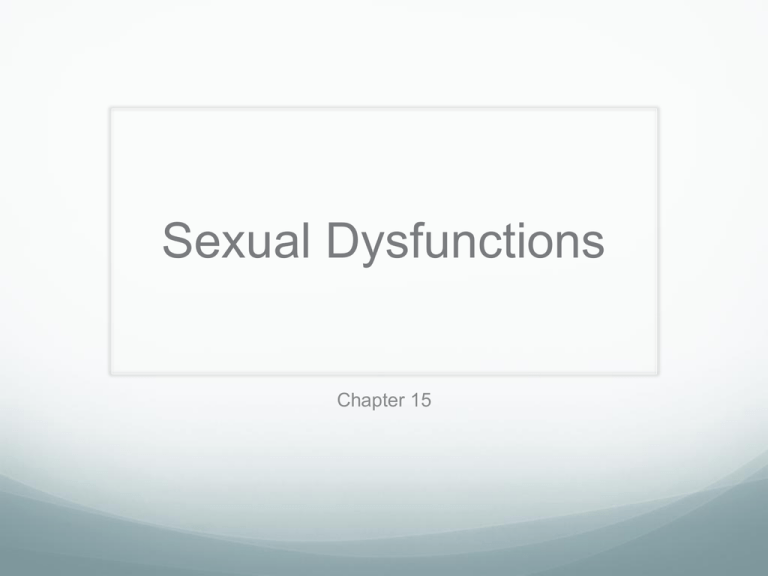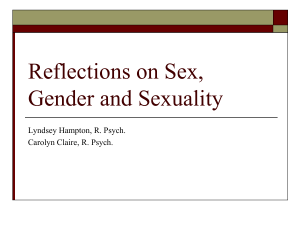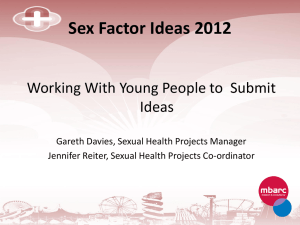
Sexual Dysfunctions
Chapter 15
Learning Objectives
Types of Sexual Dysfunctions
Origins of Sexual Dysfunctions
Treatment of Sexual Dysfunctions
Types of Sexual Dysfunctions
Sexual
Dysfunctions
• Persistent or recurrent difficulties in
becoming sexually aroused or reaching
orgasm
People with
dysfunctions
• Often avoid sexual opportunities
• Feel inadequate or incompetent
• Find it difficult to talk about
Types of Sexual Dysfunctions
No precise
figures on
occurrence
of sexual
dysfunctions
• Surveys indicate
• Women report higher prevalence
• Prevalence increases with age
• Most prevalent for women are low
sexual desire and difficulty reaching
orgasm
• Least prevalent are pain disorders
• Many men report low sexual desire
Types of Sexual Dysfunctions
DSM proposes four categories
Sexual desire
disorders
• Lack of
interest in
sex or
aversion to
sexual
contact
Sexual arousal
disorders
• Failure to
become
adequately
sexually
aroused to
engage in or
sustain
sexual
intercourse
Orgasmic
disorders
• Difficulty
reaching
orgasm or
reaching
orgasms
more rapidly
than one
would like
Sexual pain
disorders
• Persistent or
recurrent
experience of
pain during
coitus
Types of Sexual Dysfunctions
Sexual dysfunctions can be
• Lifelong
• Acquired
Sexual dysfunctions classified as
• Generalized
• Occur in all situation
• Situational
• Occur only in some situations
Critical Thinking
When does a
sexual problem
become a sexual
dysfunction?
How can concern
about a sexual
problem develop
into a dysfunction?
Sexual Desire Disorders
Hypoactive
sexual
desire
disorder
Little or no sexual interest
or desire
Most commonly
diagnosed sexual
dysfunction
Does not indicate
physical inability
More common in women
than men
Cause unclear
Absence of sexual
fantasies
Sexual Arousal Disorders
Male
erectile
disorder or
erectile
dysfunction
Persistent difficulty
achieving or maintaining
an erection sufficient to
complete sexual activity
Can be situational or
generalized
May occur due to
performance anxiety
Anxiety concerning one’s
ability to perform
behaviors, especially
behaviors that may be
evaluated by other people
May have physical
causes
Sexual Arousal Disorders
Female Persistent difficulties becoming sufficiently
lubricated in response to sexual stimulation
sexual
arousal
disorder Can be lifelong or situational
May have physical causes
Usually has psychological causes, such as
anger, resentment, or trauma
Orgasmic Disorders
Female
orgasmic
disorder
Anorgasmic
Never having reached
orgasm
Women who try to
force an orgasm
may assume a
spectator role
A role in which people
observe rather than fully
participate in their
sexual encounters
Orgasmic Disorders
Male
orgasmic
disorder
This is also termed delayed ejaculation,
retarded ejaculation, or ejaculatory
incompetence
Orgasmic Disorders
Premature
ejaculation
Ejaculation occurs with minimal sexual stimulation and
before the man desires it
Hard to define what is meant by premature
Rapid
female
orgasm
Can women reach orgasm too quickly?
It is not classified as a sexual dysfunction
May result in sexual relationship issues
Orgasmic disorders can have physical or
psychological causes
Sexual Pain Disorders
Dyspareuni
a
Persistent or recurrent pain during sexual intercourse which is commonly
caused by lack of lubrication in women and genital infections in men
Psychological factors such as guilt or anxiety could contribute to pain
Vaginismus
Involuntary contraction of the muscle surrounding the vaginal barrel
Prevents penile penetration or makes it painful
Caused by psychological fear of penetration
Vulvodynia
A gynecological condition characterized by vulva pain, burning sensations,
irritation, and soreness
Cause is unknown
Origins of Sexual Dysfunctions
• Considering
interaction of
biological,
psychological, and
Biopsychosocial social factors in
model
sexual dysfunctions
Origins of Sexual
Dysfunctions
Testosterone
deficiency
• Hypogonadism
• Reductions with age
Biological
Causes
Fatigue
Medical conditions
• Heart disease, diabetes,
MS, spinal cord injuries,
surgical complications,
hormonal problems
Origins of Sexual
Dysfunctions
HIV
• Therapy changes hormone
levels
Medications
• Hypertension
• SSRI’s
• Treat depression, panic
disorder, OCD, anorexia
• Impair sexual arousal
Substance use
• Marijuana, cocaine, alcohol,
heroin, etc.
Biological
Causes
Origins of Sexual
Dysfunctions
Cultural influences
Psychosocial
causes
• More common in sexually
repressive cultures
• Sexual double standard
• Negative sexual attitudes
Psychosexual trauma
• Sexual victimization can
negatively affect sexual
arousal
Origins of Sexual
Dysfunctions
Sexual orientation
• Sexual dysfunctions within a
heterosexual relationship
can reflect a lack of
heteroerotic interests
Ineffective sexual
techniques
• Include failure to diversify,
brevity, and lack of
communication
Emotional factors
• Include fear of losing control,
depression, and stress
Psychosocial
causes
Origins of Sexual
Dysfunctions
Problems in the
relationship
• Communication problems
• Resentment
Lack of sexual skills
Psychosocial
causes
Irrational beliefs
• When one instance of erectile or
orgasmic disorder leads to false,
catastrophic beliefs
Performance anxiety
• Can create a vicious cycle of
failure and increased anxiety
Treatment of Sexual Dysfunctions
Sex Therapy
• A collective term for short-term behavioral
models for treatment of sexual dysfunctions,
which aim to
• Change self-defeating beliefs and attitudes
• Enhance sexual knowledge
• Teach sexual skills
• Improve sexual communication
• Reduce performance anxiety
Biological treatments
Treatment of Sexual Dysfunctions
The
Helen
Singer
Kaplan
Approach
• Psychosexual therapy
• Combines behavioral and
psychoanalytic methods
• Improve sexual
communication
• Eliminate performance
anxiety
• Increase sexual skills and
knowledge
Treatment of Sexual Dysfunctions
Sexual
Desire
Disorders
• Treatments include
• Self-stimulation exercises
combined with erotic fantasies
• Sensate focus exercises
• Enhancing communication
• Expanding repertoire of
couple’s sexual skills
• Testosterone replacement
therapy
• Use of anti-anxiety
medications
• Couples therapy
Treatment of Sexual Dysfunctions
• Erectile disorder
• Sensate focus exercises are
used to reduce performance
anxiety
• Biological approaches to
treatment of erectile disorder
• Surgery (i.e., vascular
surgery or penile implants)
• Medication (e.g., Viagra)
• Vacuum pumps
Male
Sexual
Arousal
Disorders
Treatment of Sexual Dysfunctions
Female
Sexual
Arousal
Disorder
• Sex education
• Cognitive therapy
• Create non-demanding
situations
• Work on relationship problems
• Use of artificial lubricants
• Biological treatments
• Vacuum pump used on the
clitoris
• Medications also are being
investigated - controversial
Treatment of Sexual Dysfunctions
Female
Orgasmic
Disorders
• Sensate focus exercises to reduce
performance anxiety
• Use of the female-superior position
• Individual therapy (typically for
women) involves directed
masturbation programs which
include
• Education
• Self-exploration and self-massage
• Giving oneself permission
• Use of fantasy
• Use of a vibrator
• Involvement of the partner
Treatment of Sexual Dysfunctions
• Increase sexual stimulation
• Decrease performance anxiety
Male
Orgasmic
Disorder
Treatment of Sexual Dysfunctions
Premature
ejaculation
• Partner uses the squeeze
technique
• Tip of the penis is squeezed
temporarily to prevent
ejaculation
• An alternative method is the
“stop-start” method
• Biological approaches to
treatment of premature
ejaculation include the use of
psychiatric medications
Treatment of Sexual Dysfunctions
Sexual
Pain
Disorders
• Dyspareunia
• Treatment includes medical
procedures to treat infections
• Vaginismus
• Treatment involves the
insertion of vaginal dilators of
increasing size to help relax
the vaginal musculature
• Woman controls the pace
and depth of penetration
• Psychological therapy also
may be needed
Critical
Thinking
Are there
any sex
therapy
methods
that seem
“over the
top” to
you?
Explain.









